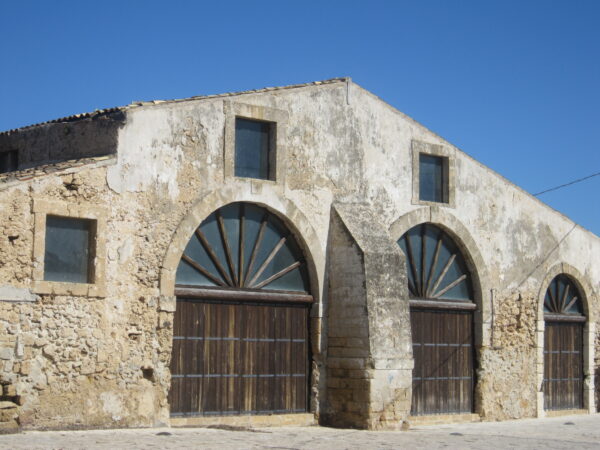Tonnara di Marzamemi
The nucleus of the tonnara consists of Piazza Regina Margherita and the manor house, built in 1752 by the Calascibettas and then managed by the Nicolaci, tonnara gabelloti, according to some descendants of an admiral Nicolajev or Nicolaus, of Anglo-Russian origin, according to others, instead, heirs of a rais of the Pizzo Calabro tonnara. The works began in 1746, on the initiative of the Calascibetta barons and were led by the masters Matteo Corso and Pasquale Alì.
The palace is in sandstone and the coat of arms of the Nicolaci family is depicted on the portal; on the upper part of the façade there are five rainwater drainage channels, in the shape of corbels ending in human faces.
Also in the square is the old church of the tonnara, built in sandstone, with a simple but elegant facade, where a small bell tower stands out on one side and an arch on the other. The church had three altars: in the center that of the Madonna of Pompeii, on both sides those of S. Antonio di Padova and S. Francesco di Paola, patron saint of Marzamemi and also kept an artistic painting depicting the Madonna del Carmelo.
Still visible are the Arab courtyard and the fishermen's cottages surrounding Piazza Regina Margherita, including the oven house and the rational house. Next to the building was built in 1912 the factory for salting tuna and then for processing in oil.
Today, in the same square stands the new church of S. Francesco di Paola, in white stone, built at the behest of Pope Pius XI and on whose façade stands out a Romanesque style rose window.
Granted on 14 February 1655, with the investiture of the Royal Court to a Spanish baron, in the first years of activity the tonnara was not lowered every year, but every other year, because it was not possible to dispose of all the tuna caught, which, in large part, were salted and stored in wooden barrels. Only from the second half of the eighteenth century was it decreased annually. The tuna traps of Marzamemi and Vendicari were purchased by Simone Calascibetta (a nobleman from Piazza Armerina and judge in Palermo) "by the Royal Tax Authority on 14 February 1655, together with those of Fiume di Noto and Santa Bonagia for a very small sum.", as reported the Memorial of the Jurors of Noto in SM, probably dating back to 1747. The pure and frank sale of hatred, with the relative titles of baron, took place for nine thousand onze. The new master was exempt from military service and passed on the privileges to the heirs. In that period Spain, after the huge costs incurred for the Thirty Years War, had an urgent need for large capitals and the sales of tuna traps and noble titles were among the measures implemented to find, in a short time, new and substantial economic revenue.
The tonnara of Marzamemi, which on average caught about 2000 tuna a year, with peaks of 2.655, 4.372, 2.735 and 3.233 respectively in the years 1902, 1904, 1905 and 1911, starting from 1922 began to have a slow but inexorable decrease of fishing, so much so that in 1926 it was decided to close the canning plant, as the few hundreds of tuna caught were sent only to the fish markets which could now be quickly reached due to the impulse taken by motorization and the appearance of some factories of ice in the Syracusan area. The canning plant had functioned on behalf of the Angelo Parodi industry of Genoa: those employed in the processing were Genoese specialists just as the Genoese was the director. The cans that were produced had as their trademark "AP Angelo Parodi Genova - Tuna in pure olive oil - Processed on the fishing spot". The canning plant was reborn in 1937, but only for one year, through the work of the noble Miss Preziosa, of the Bruno di Belmonte di Ispica barons; this time, however, for the processing of oily fish, which was landed by numerous Palermo fishing boats, which exploited the very fishy Pachino shoal, about eight miles away from Marzamemi.
After 1922, the tonnara remained active until 1943, exactly until 12 June of that year, when it was machine-gunned, with dead and wounded, by the British Air Force a few days before the Allied landing. She started working again the following year, with always modest results (a few hundred tuna caught) and her business lasted until 1969, the year in which she closed definitively.[3]. Recently, following the increase in bluefin tuna quotas, the reactivation of the tuna traps of Favignana and Marzamemi has been proposed
Text source: wikipedia
Other sources: https://reimar.it/puntodi interesse/provincia-di-messina/
Card insertion: Ignazio Caloggero
Information contributions: Web
Photo: Di Carlomorino – Own work, CC BY-SA 3.0, https://commons.wikimedia.org/w/index.php?curid=19237739
Note: The population of the cards of the Heritage database proceeds in incremental phases: cataloging, georeferencing, insertion of information and images. The cultural property in question has been cataloged, and the first information has been entered. In order to enrich the information content, further contributions are welcome, if you wish you can contribute through our area "Your Contributions"



